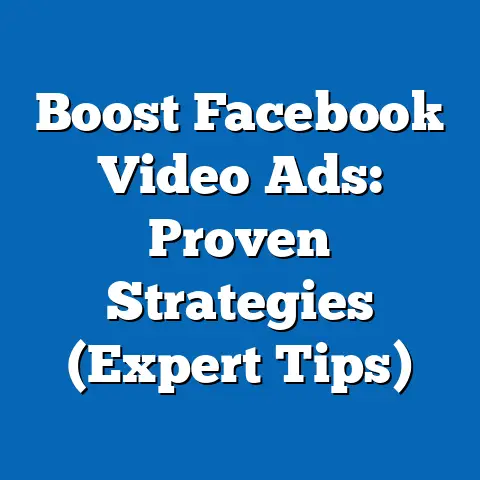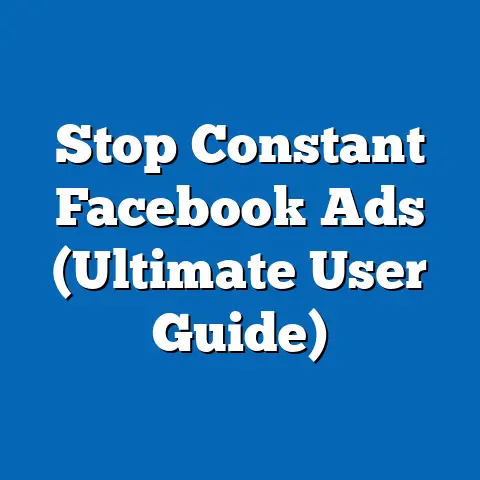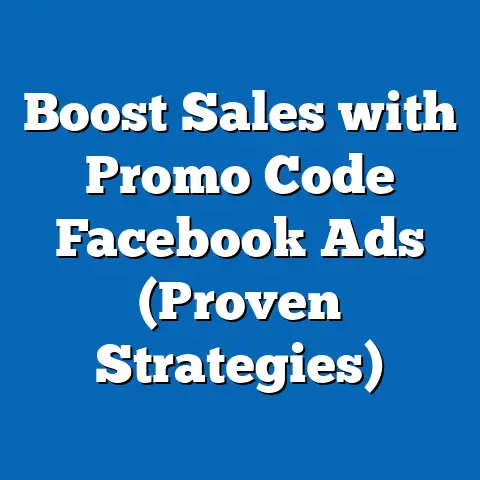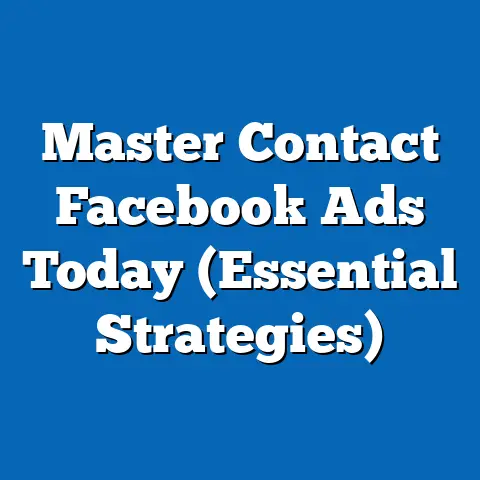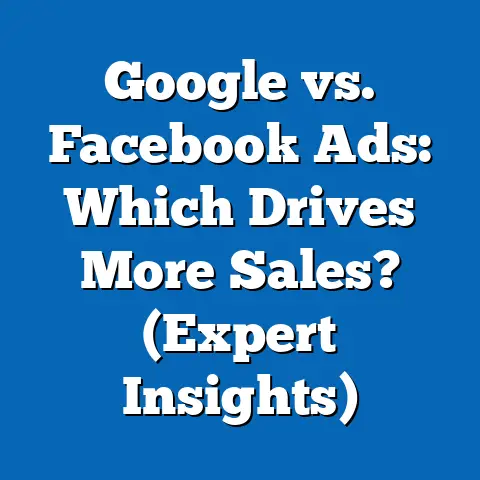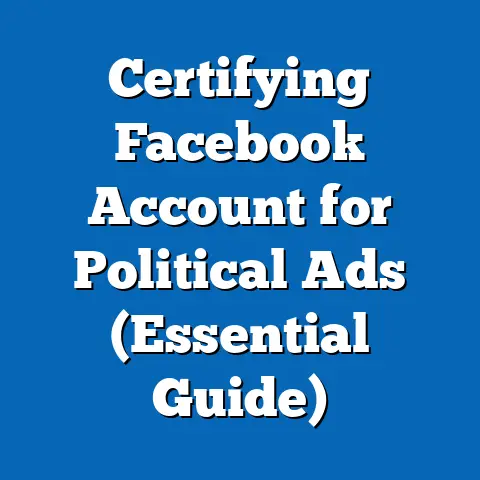Unlock Expert Facebook Ad Strategies (Proven Insights)
The unconditional love and companionship offered by pets have cemented their place as integral members of countless families. This bond has fueled a booming pet industry, with spending on our furry, feathered, and scaled friends reaching record levels year after year. As a business owner in this space, you know the passion pet owners have for their animals. But how do you tap into that passion and convert it into sales? That’s where Facebook Ads come in.
Facebook Ads, when used strategically, can be a powerful tool to connect with pet owners. However, simply throwing up any old ad and hoping for the best won’t cut it. To truly resonate with this audience, you need to understand their motivations, speak their language, and offer “pet-friendly choices” – advertising that demonstrates you understand and value their relationship with their pets.
In this guide, I’ll walk you through expert Facebook Ad strategies that I’ve personally used to help businesses in the pet industry thrive. I’ll share proven insights that will help you craft compelling campaigns, target the right audience, and ultimately, drive sales while building brand loyalty. Get ready to unlock the full potential of Facebook advertising and connect with the passionate pet-loving community.
Section 1: Understanding Your Audience
Before even thinking about crafting an ad, the first step in any successful Facebook Ads campaign is understanding your audience. This is especially critical in the pet industry because the reasons people own pets, the types of pets they own, and the products they need can vary drastically. You can’t just assume everyone loves dogs and wants the same chew toy.
The Importance of Audience Segmentation
Think of audience segmentation as slicing a cake. You wouldn’t serve the whole cake to one person, right? Similarly, you need to break down your potential customer base into distinct segments based on shared characteristics and needs.
For example, you might segment based on:
- Type of Pet: Dog owners, cat owners, bird owners, reptile owners, etc.
- Breed: Golden Retriever owners, Persian cat owners, etc. (This can be surprisingly effective!)
- Life Stage: New pet owners, owners of senior pets, etc.
- Lifestyle: Active pet owners who enjoy hiking, home-bound owners who prioritize comfort, etc.
Why is this important? Because a targeted ad is far more effective than a generic one. Imagine trying to sell a high-energy agility toy to someone who owns a lazy, senior cat. It’s not going to resonate. But if you target that same toy to owners of young, energetic dogs, you’re much more likely to make a sale.
Demographics of Pet Owners
Beyond the type of pet, understanding the demographics of pet owners is crucial. While demographics don’t tell the whole story, they provide valuable insights into their spending habits and needs.
Consider these factors:
- Age: Millennials and Gen Z are increasingly pet-centric, often delaying marriage and children in favor of pet ownership. They are also more likely to spend money on premium products and services.
- Income: Higher-income households tend to spend more on pet food, grooming, and veterinary care.
- Location: Urban pet owners may prioritize convenience and smaller living spaces, while rural owners may have more land and require different types of products.
- Lifestyle: Are they active and outdoorsy? Are they homebodies? Their lifestyle will influence the types of products and services they need.
I’ve found that using Facebook’s Audience Insights tool to analyze the demographics of my existing customers is a great starting point. It provides invaluable data about their age, gender, education level, interests, and even their online behavior.
Understanding Motivations and Pain Points
Now, let’s dig deeper. Understanding why people own pets and what challenges they face is the key to crafting truly compelling ads.
Here are some common motivations:
- Companionship: Pets provide emotional support and reduce loneliness.
- Love and Affection: The unconditional love from a pet is a powerful motivator.
- Stress Relief: Interacting with pets can lower stress levels and improve mental well-being.
- Family Enrichment: Pets can bring joy and laughter to a family.
- Activity and Exercise: Pets can encourage owners to be more active.
And here are some common pain points:
- Cost: Pet ownership can be expensive, especially when it comes to food, vet bills, and grooming.
- Time Commitment: Pets require significant time and attention.
- Behavioral Issues: Training and managing behavioral problems can be challenging.
- Health Concerns: Ensuring the health and well-being of a pet can be stressful.
- Travel: Finding pet-friendly accommodations or arranging for pet care during travel can be difficult.
Once you understand these motivations and pain points, you can tailor your ads to address them directly. For example, if you’re selling pet insurance, you can highlight the peace of mind it provides in the face of unexpected vet bills. If you’re selling a dog-walking service, you can emphasize the convenience and time savings it offers.
Examples of Successful Campaigns
Let’s look at a few examples of Facebook Ad campaigns that have effectively targeted pet owners:
- Chewy: This online pet retailer consistently runs engaging ads that showcase adorable pets and highlight their wide selection of products. They often use humor and relatable scenarios to connect with pet owners.
- The Farmer’s Dog: This fresh pet food delivery service focuses on the health benefits of their food and uses compelling visuals of happy, healthy dogs. They also offer personalized meal plans based on the dog’s breed, age, and activity level.
- Rover: This pet-sitting and dog-walking service emphasizes the safety and reliability of their platform. They use testimonials from satisfied customers and highlight the convenience of booking services through their app.
Takeaway: Understanding your audience is the foundation of any successful Facebook Ad campaign. Segment your audience based on pet type, demographics, and lifestyle. Identify their motivations and pain points, and tailor your ads to address them directly.
Section 2: Crafting Compelling Ad Content
Now that you understand your audience, it’s time to craft compelling ad content that will grab their attention and entice them to take action. This is where creativity and a deep understanding of your target audience really come into play.
The Power of Storytelling
People love stories, especially stories about pets! Storytelling is a powerful way to connect with your audience on an emotional level and make your ads more memorable.
Consider these storytelling approaches:
- Customer Testimonials: Share stories from satisfied customers about how your products or services have improved their pet’s life.
- Real-Life Pet Stories: Feature heartwarming or humorous stories about pets and their owners.
- Behind-the-Scenes Stories: Give your audience a glimpse into your company’s culture and values.
- Problem-Solution Stories: Highlight a common problem faced by pet owners and explain how your product or service solves it.
For example, I once helped a local dog groomer create a Facebook Ad campaign featuring before-and-after photos of dogs they had groomed. The ads included short testimonials from the dog owners about how happy they were with the service. These ads were incredibly effective because they showcased the tangible benefits of the grooming service and built trust with potential customers.
High-Quality Visuals
In the world of Facebook Ads, visuals are king. A captivating image or video is the first thing that will grab your audience’s attention.
Here are some tips for creating high-quality visuals:
- Use professional-grade photos and videos: Avoid blurry or poorly lit images.
- Showcase pets in action: Capture pets playing, eating, or interacting with their owners.
- Evoke emotions: Choose visuals that convey happiness, love, and joy.
- Use bright colors and eye-catching compositions: Make your ads stand out from the crowd.
- Test different visuals: Experiment with different images and videos to see what resonates best with your audience.
I’ve found that videos are particularly effective for pet-related businesses. A short video showcasing a dog playing with a new toy or a cat enjoying a comfortable bed can be incredibly engaging.
Persuasive Ad Copy
While visuals are important, your ad copy is what will ultimately convince your audience to take action.
Here are some tips for writing persuasive ad copy:
- Focus on benefits, not features: Explain how your product or service will improve the pet’s life or the owner’s life.
- Use strong verbs and action words: Create a sense of urgency and excitement.
- Address the audience’s pain points: Acknowledge their challenges and explain how you can help.
- Use social proof: Include testimonials, reviews, or statistics to build trust.
- Keep it concise and easy to read: People are scrolling quickly, so get to the point.
And most importantly, include a clear and compelling call to action (CTA). What do you want people to do after seeing your ad?
Here are some examples of effective CTAs for pet-related businesses:
- “Shop Now”
- “Learn More”
- “Book an Appointment”
- “Get a Free Quote”
- “Download Our Guide”
Takeaway: Craft compelling ad content that tells a story, uses high-quality visuals, and includes persuasive ad copy with a clear call to action. Remember to focus on the benefits of your product or service and address the audience’s pain points.
Section 3: Utilizing Facebook Ad Formats
Facebook offers a variety of ad formats, each with its own strengths and weaknesses. Choosing the right format for your campaign is crucial for maximizing its effectiveness.
Carousel Ads
Carousel ads allow you to showcase multiple images or videos in a single ad. This format is perfect for:
- Highlighting multiple products: You can showcase different products in your inventory and link each one to its respective product page.
- Telling a story: You can use the carousel format to tell a story about your brand or your products.
- Showcasing different angles of a product: You can show different views of a product to give customers a better understanding of its features.
I’ve found that carousel ads are particularly effective for pet supply stores. They can showcase a variety of products, such as toys, food, and accessories, and link each product directly to the corresponding product page on their website.
Video Ads
As I mentioned earlier, videos are incredibly engaging and can be a powerful way to connect with your audience.
Video ads are perfect for:
- Showcasing your product in action: Demonstrate how your product works and highlight its benefits.
- Telling a story: Share heartwarming or humorous stories about pets and their owners.
- Building brand awareness: Create a video that introduces your brand and its values.
Remember to keep your videos short and engaging. People have short attention spans, so you need to grab their attention quickly and keep them hooked.
Slideshow Ads
Slideshow ads are a cost-effective alternative to video ads. They allow you to create a video-like experience using a series of still images.
Slideshow ads are perfect for:
- Creating a quick and easy video: You don’t need to hire a professional videographer to create a slideshow ad.
- Showcasing a product’s features: You can use a series of images to highlight the different features of your product.
- Telling a story: You can use a series of images to tell a story about your brand or your products.
Dynamic Ads
Dynamic ads are a powerful way to retarget pet owners who have shown interest in specific products on your website. These ads automatically display the products that the user has viewed, reminding them of their interest and encouraging them to complete the purchase.
I’ve seen dynamic ads work wonders for e-commerce businesses in the pet industry. They are highly personalized and relevant, which leads to higher click-through rates and conversion rates.
Facebook Stories
Facebook Stories are a great way to engage with your audience in a more interactive and informal way. Stories disappear after 24 hours, which creates a sense of urgency and encourages people to view them.
Facebook Stories are perfect for:
- Sharing behind-the-scenes content: Give your audience a glimpse into your company’s culture and values.
- Running contests and giveaways: Encourage engagement by asking people to participate in contests or giveaways.
- Promoting limited-time offers: Create a sense of urgency by promoting limited-time offers in your stories.
Takeaway: Experiment with different Facebook Ad formats to see what works best for your business. Carousel ads are great for showcasing multiple products, video ads are perfect for engaging your audience, and dynamic ads are a powerful way to retarget potential customers. Don’t forget to utilize Facebook Stories for more interactive and engaging content.
Section 4: Targeting Strategies for Pet Owners
Now that you have compelling ad content and you’ve chosen the right ad formats, it’s time to target your ads to the right audience. Facebook offers a wealth of targeting options that can help you reach pet owners who are most likely to be interested in your products or services.
Custom Audiences
Custom Audiences allow you to target people who have already interacted with your business. You can create Custom Audiences based on:
- Website Visitors: Target people who have visited your website.
- Customer List: Upload a list of your existing customers.
- App Users: Target people who have downloaded your app.
- Engagement: Target people who have interacted with your Facebook page or Instagram profile.
Custom Audiences are incredibly powerful because they allow you to target people who are already familiar with your brand.
Lookalike Audiences
Lookalike Audiences allow you to reach new people who are similar to your existing customers. You can create a Lookalike Audience based on:
- Website Visitors: Facebook will find people who are similar to those who have visited your website.
- Customer List: Facebook will find people who are similar to your existing customers.
- Page Fans: Facebook will find people who are similar to those who have liked your Facebook page.
Lookalike Audiences are a great way to expand your reach and find new potential customers.
Interest and Behavior Targeting
Facebook also allows you to target people based on their interests and behaviors. This is a great way to reach people who are interested in pet care, animal welfare, or specific breeds of pets.
Here are some examples of interests you can target:
- Pet care
- Animal welfare
- Dog training
- Cat grooming
- Specific breeds of dogs or cats
And here are some examples of behaviors you can target:
- Pet ownership
- Frequent pet supply purchases
- Interest in pet insurance
- Membership in pet-related groups
I’ve found that combining interest and behavior targeting with demographic targeting can be incredibly effective. For example, you could target women aged 25-45 who are interested in dog training and have purchased pet supplies online in the past.
Case Studies
Let’s look at a few case studies of businesses that have successfully used Facebook’s targeting features to reach pet owners:
- A local pet store: This store used Custom Audiences to target people who had visited their website and abandoned their shopping carts. They offered these customers a discount on their purchase, which led to a significant increase in sales.
- An online pet food company: This company used Lookalike Audiences to reach new customers who were similar to their existing customers. They saw a significant increase in brand awareness and sales.
- A dog-walking service: This service used interest and behavior targeting to reach people who were interested in dog care and lived in their service area. They saw a significant increase in bookings.
Takeaway: Leverage Facebook’s powerful targeting options to reach pet owners who are most likely to be interested in your products or services. Use Custom Audiences to target people who have already interacted with your business, Lookalike Audiences to reach new potential customers, and interest and behavior targeting to reach people who are interested in pet care and animal welfare.
Section 5: Analyzing and Optimizing Ad Performance
Creating a great ad and targeting the right audience is only half the battle. You also need to track and analyze your ad performance to see what’s working and what’s not. This will allow you to optimize your campaigns and improve your results over time.
Key Performance Indicators (KPIs)
Here are some key performance indicators (KPIs) to focus on when analyzing your Facebook Ad performance:
- Click-Through Rate (CTR): The percentage of people who saw your ad and clicked on it. A high CTR indicates that your ad is relevant and engaging.
- Conversion Rate: The percentage of people who clicked on your ad and completed a desired action, such as making a purchase or filling out a form. A high conversion rate indicates that your landing page is effective and your offer is compelling.
- Cost Per Click (CPC): The amount you pay each time someone clicks on your ad. A low CPC indicates that your ad is efficient.
- Cost Per Conversion (CPC): The amount you pay each time someone completes a desired action. A low CPC indicates that your campaign is effective.
- Return on Ad Spend (ROAS): The amount of revenue you generate for every dollar you spend on advertising. A high ROAS indicates that your campaign is profitable.
I recommend tracking these KPIs on a regular basis and using them to make informed decisions about your campaigns.
A/B Testing
A/B testing is a process of comparing two versions of an ad to see which one performs better. You can A/B test different elements of your ads, such as:
- Images: Test different images to see which one is most engaging.
- Headlines: Test different headlines to see which one is most compelling.
- Ad Copy: Test different ad copy to see which one is most persuasive.
- Call to Action: Test different calls to action to see which one generates the most conversions.
- Targeting: Test different targeting options to see which one reaches the most relevant audience.
A/B testing is a great way to refine your campaigns and improve your results over time.
Gathering Customer Feedback
In addition to tracking KPIs and A/B testing, it’s also important to gather feedback from your customers. This can help you understand what they like and dislike about your ads and your products or services.
Here are some ways to gather customer feedback:
- Surveys: Send out surveys to your customers to ask them about their experiences.
- Reviews: Encourage your customers to leave reviews on your website or on third-party review sites.
- Social Media: Monitor your social media channels for mentions of your brand and respond to comments and questions.
- Customer Service: Train your customer service representatives to gather feedback from customers.
Takeaway: Continuously analyze and optimize your Facebook Ad performance. Track key performance indicators (KPIs), A/B test different ad elements, and gather feedback from your customers to refine your campaigns and improve your results over time.
Conclusion
Facebook Ads offer a powerful platform for connecting with pet owners, a passionate and lucrative audience. By understanding their motivations, crafting compelling content, leveraging the right ad formats, and employing precise targeting strategies, you can unlock the full potential of your Facebook advertising efforts.
Remember to continuously analyze your ad performance, A/B test different elements, and gather feedback from your customers to refine your campaigns and improve your results over time.
By implementing these expert strategies, you can foster brand growth, build customer loyalty, and ultimately, achieve your business goals in the pet industry. Now go out there and create some paw-some ads!

